There’s an old Greek shipping saying that goes: “Ninety-eight tankers and 101 cargoes, boom. Ninety-eight cargoes and 101 tankers, bust.” This doesn’t translate so well into modern-day container shipping because the consolidated liner sector manages the number of ships in service a lot better than the fragmented tanker business.
Tanker spot rates can plunge violently lower when supply exceeds demand. One of the big questions for container shipping has been: Will spot rates plunge precipitously after demand pulls back, as it has in the past in bulk commodity shipping? Or will there be a gradual decline toward a soft landing?
So far, it looks gradual. Trans-Pacific rates have steadied in July and early August. In fact, some indexes show spot rates ticking higher again.
Spot rates are at least temporarily plateauing because U.S. import demand remains above pre-COVID levels, some U.S. ports remain extremely congested, and ocean carriers are “blanking” or “voiding” (i.e., canceling) sailings, both because their ships are stuck in port queues and because they’re matching vessel supply with cargo demand to avert the fate of Greek tanker owners.
“Void sailings are still the go-to options for carriers at this point to try and stymie the fall in rates,” said George Griffiths, managing editor of global container freight at S&P Global Commodities.
“Congestion is still the buzzword for East Coast ports, with Savannah currently feeling the full force of loaded imports and associated delays,” he told American Shipper.
FBX trans-Pac rates up 3% from recent lows
Different spot indexes give different rate assessments but generally show the same trends. The Freightos Baltic Daily Index (FBX) Asia-West Coast assessment was at $6,692 per forty-foot equivalent unit on Friday.
The good news for shippers booking spot cargo: That’s just one-third of the all-time peak this index reached in September. The bad news: Friday’s assessment is up 2.7% from the low of $6,519 per FEU hit on Aug. 2, and it’s still 4.5 times higher than the rate at this time of year in 2019, pre-COVID.
The FBX Asia-East Coast spot rate assessment was at $9,978 per FEU on Friday, less than half the record high in September. However, it was up 3.5% from the recent low of $9,640 on Aug. 2 and still 3.6 times higher than 2019 levels.
Drewry indexes show gradual slide
The weekly index from Drewry portrays a gentler descent than the FBX, because Drewry did not include premium charges in its spot assessments at the peak.
Unlike the FBX, Drewry’s Shanghai-Los Angeles assessment does not show a recent uptick. It was at $6,985 per FEU for the week announced last Thursday, its lowest point since June 2021. It was down 44% from its all-time high in late November 2021, albeit still 4.2 times higher than rates at this time of year in 2019.
Drewry’s weekly Shanghai-New York assessment was at $9,774 per FEU on Friday. Rates were relatively stable over the past two week, yet the latest reading is the lowest since June 2021 and down 40% from the peak in mid-September.
Drewry’s Shanghai-New York assessment on this route is still 3.5 times pre-COVID levels.
S&P Global: East Coast rates 50% higher than West Coast
Daily assessments from S&P Global Commodities (formerly Platts) show a widening divergence between North Asia-West Coast and North Asia-East Coast Freight All Kinds (FAK) rates.
S&P Global assessed Friday’s North Asia-East Coast FAK rate at $9,750 per FEU, up 2.6% from the recent low hit on July 29. Spot rates on this route have roughly plateaued since late April, according to this index.
S&P Global put Friday’s North Asia-West Coast rate at $6,500 per FEU, still gradually falling and at the lowest point since late June 2021. The gap with East Coast assessments has been widening since May, with the East Coast rates now 50% higher than West Coast rates.
Port congestion still very high
Matthew Cox, CEO of ocean carrier Matson (NYSE: MATX) explained on his company’s quarterly call earlier this month: “In fall of last year, we saw over 100 vessels waiting at anchor or offshore waiting to get into the ports of Los Angeles and Long Beach. We still have 100 ships waiting. But a lot of that congestion has moved into different ports. We [have] the same number of ships but just more distributed to different places.”
The number of ships waiting off all North American ports topped 150 in late July, according to an American Shipper survey of ship-position data from MarineTraffic and queue lists for Los Angeles/Long Beach and Oakland, California.
The count fluctuates by the day (and by the hour as ships enter and leave queues) and is now down 15% from its peak — but still historically high. As of Monday morning, there were 130 ships waiting offshore. East and Gulf Coast ports accounted for 71% of the total, with the West Coast share falling to just 29%.
The queue off Savannah, Georgia, was the largest at 39 ships on Monday morning. It was considerably higher just a few days earlier. According to Hapag-Lloyd, there were 48 container vessels off Savannah on Friday, with wait times of 14-18 days.
The queue off Los Angeles/Long Beach has now virtually vanished. On Monday morning, it was down to just 11 container vessels, according to the queue list from the Marine Exchange of Southern California. It hasn’t been that low since November 2020. It hit a high of 109 ships on Jan. 9.
Spot rate easing expected to continue
On last Wednesday’s quarterly call by ocean carrier Maersk, CFO Patrick Jany said port congestion preempted a steeper drop in spot rates. Even with support from congestion, he predicted short-term rates will decline further in the months ahead.
“We have seen an erosion of short-term rates in the past few months that has been stopped here and there by renewed or new disruptions,” Jany said. “The erosion of the short-term rates will continue. It won’t be a one-day drop but a progressive erosion toward a lower level of short-term rates in the fourth quarter.”
Jany predicted that when rates stop falling, they “will stabilize at a higher level than they were in the past [pre-COVID] and higher than our cost level.”
During the latest quarterly call by logistics provider Kuehne + Nagel, CEO Detlef Trefzger predicted rates would ultimately settle at levels two to three times pre-COVID rates. A Seko Logistics executive made the same prediction during a recent briefing.
According to Cox at Matson, spot rates “are adjusting slowly. There’s no falling off a cliff. The word we use is ‘orderly.’ We’re seeing rates decline from their peak, but … we expect an orderly marketplace for the remainder of the year, with our vessels continuing to operate at or near capacity.”
Source: Freight Waves by Greg Miller, https://www.freightwaves.com/news/no-precipitous-plunge-in-container-shipping-rates-just-orderly-decline





